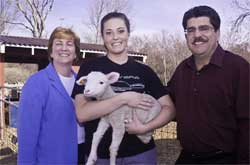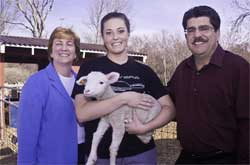 Demand for large animal vets gives URI students advantage
Demand for large animal vets gives URI students advantage
KINGSTON, R.I. – April 15, 2010 – The high rate of acceptance to veterinary schools achieved by University of Rhode Island animal science students might be considered extraordinary, given the small number of accredited vet schools in the country and their reputed selectivity. But the increasing demand for large animal veterinarians and the extensive hands-on experience that URI students have with these animals provides them with a distinct advantage.
According to URI Animal Science Professor Anthony Mallilo, the nation’s 28 vet schools admit just 10 percent of those who apply, but 75-80 percent of URI students are admitted to at least one vet school on their first try. Because most veterinary schools are public institutions that primarily cater to in-state students, they typically only accept 2-4 percent of out-of-state applicants, making URI’s achievement even more significant.
“The students who deserve to get in to vet school do get in,” said Mallilo. “We give them hands on experience with lab animals, farm animals and companion animals, and that’s what vet schools are looking for.”
“Most students start out thinking they want to be small animal vets, but often the experience we give them with large food animals changes their minds,” added Darlene Jones, a veterinarian and URI animal science lecturer who serves on the board of the R.I. Veterinary Medical Association. “Many vet schools are looking for students with experience in food animals.”
That’s what happened when URI senior Jennifer Halleran enrolled at URI. A New Jersey native, she started out wanting to be a small animal vet, but her experience working with pigs at URI changed her mind.
“Now I want to be a large animal vet and especially focus on swine,” said Halleran, who was admitted to several vet schools and has chosen to attend Colorado State University. “I want to practice veterinary medicine first, and then maybe get into research. Pigs are increasingly being used in human medicine, and that’s something that really interests me.”
While there is a nationwide shortage of large animal veterinarians, there is also a shortage of laboratory animal veterinarians, a little-known specialty that is also in great demand to care for the 10 million laboratory animals at biotechnology labs and other research facilities in the United States.
Ellen Scherer, a URI senior from Port Allegheny, Penn., credits an internship she had at Massachusetts General Hospital’s Center for Comparative Medicine for sparking her interest in working with laboratory animals.
“It was a really unique research opportunity that has an influence on human health and benefits people,” she said. “I did rodent health monitoring, animal husbandry, post-operative care. I treated health conditions and administered special diets and pain medications. It was a great experience.”
Scherer has been accepted to the Ohio State University vet school.
Mallilo and Jones note that there is an increasing demand for veterinary technicians as well, and they are preparing a proposal to create a 4-year degree program in this discipline to prepare students to assist licensed veterinarians.
“We have students entering school with a variety of non-traditional veterinary interests,” Jones said. “Hopefully some of them will come back to Rhode Island after vet school and have a positive impact on the state’s animal population when they return.”
Pictured above
URI Animal Science Professors Darlene Jones (left) and Tony Mallilo (right) flank student Ellen Scherer, who will enroll in the vet school at Ohio State University next fall. URI Department of Communications & Marketing photo by Michael Salerno Photography.

